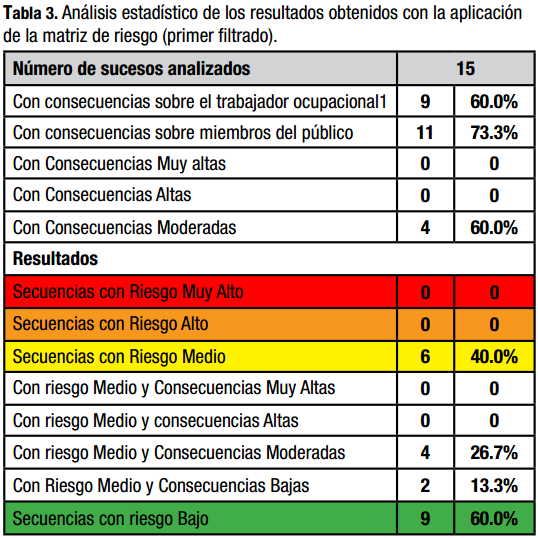Application of the risk matrix methodology in the safety analysis of the practice of radiotracers in the industry
Main Article Content
Abstract
The use of substances to diagnose or identify a system specific phase, that is, which function as tracers, is an effective tool in the study of multiple phenomena. There are several kinds of tracers and, within them, radioactive tracers are the most sensitive and used for the study and online diagnosis of many systems, hence their use in industrial processes has an extensive use.
However, an authorization from the National Regulatory Body is necessary to use radioactive sources. The safety assessment, the radiation protection program, operational and safety procedures as well as the emergency plan were prepared and presented to the Regulatory Body to apply for authorization.
The safety assessment includes the dose estimations for normal operations and potential doses in accidental situations. The safety analysis used the methodology of risk matrixes. As a result, it was obtained that the doses under normal operating conditions comply with the annual limits for occupationally exposed workers and for the public, while the risk levels are predominantly low, so it was concluded that it is possible to carry out the practice under adequate security conditions and the CPHR obtained the operating license.
Article Details

This work is licensed under a Creative Commons Attribution-NonCommercial 4.0 International License.
Aquellos autores/as que tengan publicaciones con esta revista, aceptan los términos siguientes:
- Los autores/as conservarán sus derechos de autor y garantizarán a la revista el derecho de primera publicación de su obra, el cuál estará simultáneamente sujeto a la Licencia Creative Commons Attribution-NonCommercial 4.0 International (CC BY-NC 4.0) que permite a terceros compartir la obra siempre que se indique su autor y su primera publicación esta revista. Bajo esta licencia el autor será libre de:
- Compartir — copiar y redistribuir el material en cualquier medio o formato
- Adaptar — remezclar, transformar y crear a partir del material
- El licenciador no puede revocar estas libertades mientras cumpla con los términos de la licencia
Bajo las siguientes condiciones:
- Reconocimiento — Debe reconocer adecuadamente la autoría, proporcionar un enlace a la licencia e indicar si se han realizado cambios. Puede hacerlo de cualquier manera razonable, pero no de una manera que sugiera que tiene el apoyo del licenciador o lo recibe por el uso que hace.
- NoComercial — No puede utilizar el material para una finalidad comercial.
- No hay restricciones adicionales — No puede aplicar términos legales o medidas tecnológicas que legalmente restrinjan realizar aquello que la licencia permite.
- Los autores/as podrán adoptar otros acuerdos de licencia no exclusiva de distribución de la versión de la obra publicada (p. ej.: depositarla en un archivo telemático institucional o publicarla en un volumen monográfico) siempre que se indique la publicación inicial en esta revista.
- Se permite y recomienda a los autores/as difundir su obra a través de Internet (p. ej.: en archivos telemáticos institucionales o en su página web) antes y durante el proceso de envío, lo cual puede producir intercambios interesantes y aumentar las citas de la obra publicada. (Véase El efecto del acceso abierto).
La Revista Nucleus solo aceptará contribuciones que no hayan sido previamente publicados y/o procesados, por otra publicación. Cualquier violación ese sentido será considerada una falta grave por parte del autor principal lo cual será objeto valoración por parte del Consejo Editorial, el cual dictaminará al respecto.
References
[2].International Atomic Energy Agency (IAEA). Use of radiotracers to study surface water processes. IAEA-TECDOC-1760. Vienna: IAEA, 2015.
[3]. International Atomic Energy Agency (IAEA). Industrial applications of sealed radioactive sources. IAEA-TECDOC-1925. Vienna: IAEA, 2020.
[4]. Colectivo de autores. Protección radiológica en la aplicación de las técnicas nucleares. CPHR y CNSN. La Habana, 2002.
[5]. Ministerio de Ciencia, Tecnología y Medio Ambiente (CITMA). Reglamento sobre notificación y autorización de prácticas y actividades asociadas al empleo de fuentes de radiaciones ionizantes. Resolución No. 334/2011.
[6]. Centro Nacional de Seguridad Nuclear. Evaluación de seguridad de prácticas y actividades asociadas al empleo de fuentes de radiaciones ionizantes. Guía de Seguridad. Resolución No. 17/2012. La Habana, 2012.
[7]. Foro Iberoamericano de Organismos Reguladores. Aplicación del método de la matriz de riesgo en radiografía industrial. Volumen 1. Texto Principal. Junio, 2016.
[8]. Centro de Protección e Higiene de las Radiaciones (CPHR). Expediente de seguridad de la práctica de trazadores radiactivos. Versión 3. Junio, 2021.

